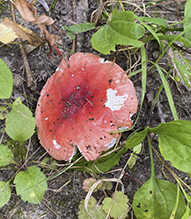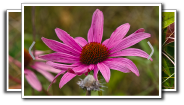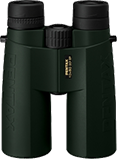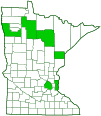Bloody Brittlegill
(Russula sanguinea)
Conservation • Description • Habitat • Ecology • Distribution • Taxonomy
Conservation Status |
|
|||||||
| IUCN Red List | not listed |
|||||||
| NatureServe | not listed |
|||||||
| Minnesota | not listed |
|||||||
Description |
||
Bloody Brittlegill is a colorful, medium-sized mushroom. It occurs in Europe, Asia, Australia, and North America. In the United States it is common west of the Rocky Mountains, widespread but uncommon in the east. It is found in summer and fall. It grows on the ground under coniferous trees that have just two needles. In Minnesota it is associated only with red pine. On the West Coast it also grows under Bishop pine. It has a mutually beneficial relationship (mycorrhizal) with the tiny rootlets of trees, absorbing sugars and amino acids while helping the tree absorb water. When it first appears the cap is convex, dark red to bright red, hairless, and sticky. As it ages it flattens out, becoming broadly convex to flat and often depressed in the middle. It sometimes fades to pink toward the edges but usually remains dark in the middle. Mature caps are ¾″ to 4″ (2 to 10 cm) in diameter. The margins are only slightly lined and are sometimes turned upward. The upper surface is sticky when wet. The gills are closely spaced and broadly attached to the stalk, sometimes slightly running down the stalk. They are white at first, becoming pale yellow with age. The stalk is firm, dry, fairly smooth, 1¼″ to 4″ (3 to 10 cm) long, ⅝″ to 1″ (15 to 25 mm) thick. It is white and flushed with the cap color. West Coast mushrooms have a dark red stem. The flesh is white and brittle. It does not change color when sliced. It is not known if it is poisonous, but the acrid taste is enough to dissuade a forager from eating it. The spore print is pale yellow or orangish-yellow. |
||
Similar Species |
||
Russula tenuiceps is extremely fragile, has a weak stem, and grows under oaks and other hardwoods. It is much less common and has not been recorded in Minnesota. |
||
Habitat and Hosts |
||
Grows under red pine |
||
Ecology |
||
Season |
||
Summer and fall |
||
Distribution |
||||
|
Sources |
|||
| 10/18/2022 | ||||
Occurrence |
||||
|
||||
Taxonomy |
|||
| Kingdom | Fungi (fungi) | ||
| Subkingdom | Dikarya | ||
| Phylum | Basidiomycota (club fungi) | ||
| Subphylum | Agaricomycotina (jelly fungi, yeasts, and mushrooms) | ||
| Class | Agaricomycetes (mushrooms, bracket fungi, puffballs, and allies) | ||
| Subclass | Agaricomycetidae | ||
| Order | Russulales | ||
| Family | Russulaceae (milkcaps, brittlegills, and allies) | ||
Genus |
Russula (brittlegills) | ||
Subgenus |
Russula | ||
North American mushrooms currently treated as Russula sanguinea are probably at least two distinct species, neither of which is the same as the European Russula sanguinea. Mushrooms on the West Coast have a dark red stem. Those in the east have a white stem flushed with red. |
|||
Synonyms |
|||
Agaricus sanguineus |
|||
Common Names |
|||
Bloody Brittlegill |
|||
Glossary
Mycorrhizal
A symbiotic, usually beneficial relationship between a fungus and the tiny rootlets of a plant, usually a tree.
Visitor Photos |
|||||
Share your photo of this fungus. |
|||||
| This button not working for you? Simply email us at info@MinnesotaSeasons.com. Attach one or more photos and, if you like, a caption. |
|||||
Sandy Jacoby |
|||||
 |
|||||
MinnesotaSeasons.com Photos |
|||||
|
|||||

Slideshows |
||

Visitor Videos |
|||
Share your video of this fungus. |
|||
| This button not working for you? Simply email us at info@MinnesotaSeasons.com. Attach a video, a YouTube link, or a cloud storage link. |
|||
Other Videos |
|||

Visitor Sightings |
|||||
Report a sighting of this fungus. |
|||||
| This button not working for you? Simply email us at info@MinnesotaSeasons.com. Be sure to include a location. |
|||||
|
|
||||
MinnesotaSeasons.com Sightings |
|||||
|
|||||

Created: 10/18/2022
Last Updated:
